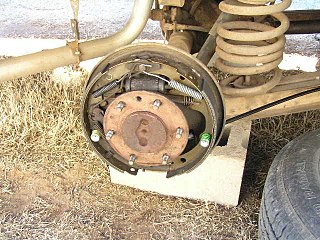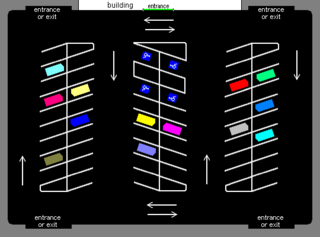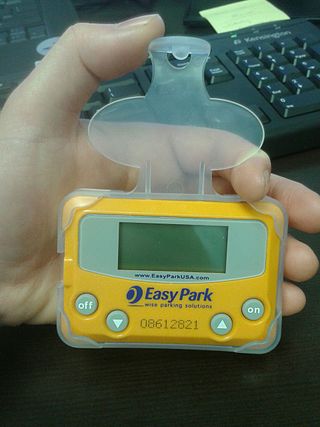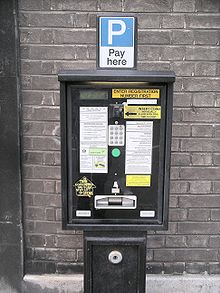
A drum brake is a brake that uses friction caused by a set of shoes or pads that press outward against a rotating cylinder-shaped part called a brake drum.

A toll road, also known as a turnpike or tollway, is a public or private road for which a fee is assessed for passage. It is a form of road pricing typically implemented to help recoup the costs of road construction and maintenance.

A parking meter is a device used to collect money in exchange for the right to park a vehicle in a particular place for a limited amount of time. Parking meters can be used by municipalities as a tool for enforcing their integrated on-street parking policy, usually related to their traffic and mobility management policies, but are also used for revenue.

Parking is the act of stopping and disengaging a vehicle and leaving it unoccupied. Parking on one or both sides of a road is often permitted, though sometimes with restrictions. Some buildings have parking facilities for use of the buildings' users. Countries and local governments have rules for design and use of parking spaces.

Electronic toll collection (ETC) is a wireless system to automatically collect the usage fee or toll charged to vehicles using toll roads, HOV lanes, toll bridges, and toll tunnels. It is a faster alternative which is replacing toll booths, where vehicles must stop and the driver manually pays the toll with cash or a card. In most systems, vehicles using the system are equipped with an automated radio transponder device. When the vehicle passes a roadside toll reader device, a radio signal from the reader triggers the transponder, which transmits back an identifying number which registers the vehicle's use of the road, and an electronic payment system charges the user the toll.

A parking lot or car park, also known as a car lot, is a cleared area intended for parking vehicles. The term usually refers to an area dedicated only for parking, with a durable or semi-durable surface. In most countries where cars are the dominant mode of transportation, parking lots are a feature of every city and suburban area. Shopping malls, sports stadiums, megachurches and similar venues often have immense parking lots.
Vehicle Excise Duty is an annual tax that is levied as an excise duty and which must be paid for most types of powered vehicles which are to be used on public roads in the United Kingdom. Registered vehicles that are not being used or parked on public roads and which have been taxed since 31 January 1998, must be covered by a Statutory Off Road Notification (SORN) to avoid VED. In 2016, VED generated approximately £6 billion for the Exchequer.

A traffic ticket is a notice issued by a law enforcement official to a motorist or other road user, indicating that the user has violated traffic laws. Traffic tickets generally come in two forms, citing a moving violation, such as exceeding the speed limit, or a non-moving violation, such as a parking violation, with the ticket also being referred to as a parking citation, or parking ticket.

Intelligent Parking Assist System (IPAS), also known as Advanced Parking Guidance System (APGS) for Toyota models in the United States, is the first production automatic parking system developed by Toyota Motor Corporation in 1999 initially for the Japanese market hybrid Prius models and Lexus models. The technology assists drivers in parking their vehicle. On vehicles equipped with the IPAS, via an in-dash screen and button controls, the car can steer itself into a parking space with little input from the user. The first version of the system was deployed on the Prius Hybrid sold in Japan in 2003. In 2006, an upgraded version debuted for the first time outside Japan on the Lexus LS luxury sedan, which featured the automatic parking technology among other brand new inventions from Toyota. In 2009, the system appeared on the third generation Prius sold in the U.S. In Asia and Europe, the parking technology is marketed as the Intelligent Park Assist System for both Lexus and Toyota models, while in the U.S. the Advanced Parking Guidance System name is only used for the Lexus system.
Muni Meter is the name used by the New York City Department of Transportation (NYCDOT) for its pay and display centralized parking meter system. The Muni Meter system was introduced broadly in 2009, following a period of experimentation that began in 1999. Muni Meters are located on streets adjacent to a group of parking spots, with no designated striping that separates spots. A driver parks their car, pays at the Muni Meter, and takes a receipt provided by the Meter. They then display that receipt on their vehicle's dashboard. The system reduces the number of individual meter devices required, increases the number of parking spots available and, some argue, reduces losses due to unused time left on meters.

A parking violation is the act of parking a motor vehicle in a restricted place or in an unauthorized manner. It is against the law virtually everywhere to park a vehicle in the middle of a highway or road; parking on one or both sides of a road, however, is commonly permitted. However, restrictions apply to such parking, and may result in an offense being committed. Such offenses are usually cited by a police officer or other government official in the form of a traffic ticket.

A backup camera is a special type of video camera that is produced specifically for the purpose of being attached to the rear of a vehicle to aid in backing up and to alleviate the rear blind spot. It is designed to avoid a backup collision. The area directly behind vehicles has been described as a "killing zone" due to associated accidents. Backup cameras are usually connected to the vehicle head unit display. A common variant is a Surround View system, which assembles a synthetic but positionally accurate top-down view of the vehicle and its adjacencies.

A disabled parking permit, also known as a disabled badge, disabled placard, handicapped permit, handicapped placard, handicapped tag, and "Blue Badge" in the European Union, is a permit that is displayed upon parking a vehicle. It gives the operator of a vehicle permission to special privileges regarding the parking of that vehicle. These privileges include parking in a space reserved for persons with disabilities, or, in some situations, permission to park in a time-limited space for a longer time, or to park at a meter without payment.

Video tolling is a form of electronic toll collection that uses video or still images of a vehicle's license plate to identify a vehicle liable to pay a road toll. The system dispenses with collection of road tolls using road-side cash or payment card methods, and may be used in conjunction with "all electronic" open road tolling, to permit drivers without an RFID device to use the toll road.

Bold Lane is a street in Derby. It was said to hold one of the most secure places in the world, a multi-storey car park. The car park is a 10-floor building with 440 parking bays, it is open 24 hours a day. Operated by Parksafe Systems, it has been listed as one of the most secure places in the world in a general interest news report. Security experts are generally amused by this claim, noting that bank vaults, prisons and military bases are generally seen as more secure. Competing car parks in the area are cheaper and closer to the main shopping centre but Bold Lane is still frequently used by shoppers.

Pay-by-phone parking allows any driver parking in a fare required space the option to divert the expense to a credit card or to a mobile network operator via the use of a mobile phone, mobile application or computer, opposed to inserting cash into a parking meter or pay and display machine. SMS pay-by-phone parking was invented by young Croatian innovators and introduced by Vipnet. Since its introduction in Croatian capital Zagreb in 2001 under name M-parking, the number of registered users has steadily increased. By 2004, the Croatian M-parking scheme was the largest in Europe. Today, pay-by-phone parking is used by millions of people all around the world.
The British Parking Association Limited (BPA), is a British-based trade association that focuses on parking and traffic management fields. The association is a company limited by guarantee, and non-profit organisation founded in 1968, though was not registered until 1970.
Pay-by-plate machines are a subset of ticket machines used for regulating parking in urban areas or in parking lots. They enable customers to purchase parking time by using their license plate number. The machines print a receipt that generally displays the location, machine number, start time, expiration time, amount paid, and license plate.

An in-vehicle parking meter(IVPM) (also known as in-vehicle personal meter, in-car parking meter, or personal parking meter) is a handheld electronic device, roughly the size of a pocket calculator, that drivers display in their car windows either as a parking permit or as proof of parking payment. IVPM was first implemented in the late 1980s in Arlington, VA, and is spreading to campuses and municipalities worldwide as a centralized method of parking management, revenue collection, and compliance enforcement.

A car's internal costs are all the costs consumers pay to own and operate a car. Normally these expenditures are divided into fixed or standing costs and variable or running costs. Fixed costs are those which do not depend on the distance traveled by the vehicle and which the owner must pay to keep the vehicle ready for use on the road, like insurance or road taxes. Variable or running costs are those that depend on the use of the car, like fuel or tolls.






















